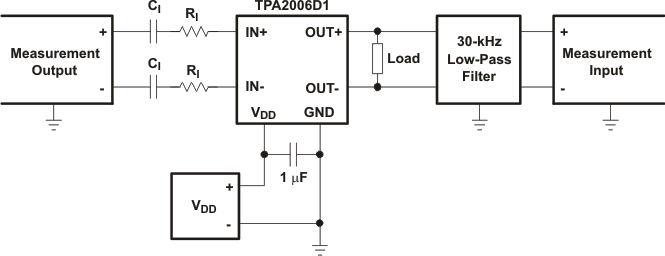SLOS498B September 2006 – September 2015 TPA2006D1
PRODUCTION DATA.
- 1 Features
- 2 Applications
- 3 Description
- 4 Revision History
- 5 Device Comparison Table
- 6 Pin Configuration and Functions
- 7 Specifications
- 8 Parameter Measurement Information
- 9 Detailed Description
- 10Application and Implementation
- 11Power Supply Recommendations
- 12Layout
- 13Device and Documentation Support
- 14Mechanical, Packaging, and Orderable Information
Package Options
Mechanical Data (Package|Pins)
- DRB|8
Thermal pad, mechanical data (Package|Pins)
- DRB|8
Orderable Information
8 Parameter Measurement Information
All parameters are measured according to the conditions described in the Specifications section.

A. CI is shorted for any common-mode input voltage measurement.
B. A 33-μH inductor is placed in series with the load resistor to emulate a small speaker for efficiency measurements.
C. The 30-kHz low-pass filter is required even if the analyzer has an internal low-pass filter. An RC low-pass filter
(100 Ω, 47 nF) is used on each output for the data sheet graphs.
Figure 27. Test Set-up for Graphs
(100 Ω, 47 nF) is used on each output for the data sheet graphs.